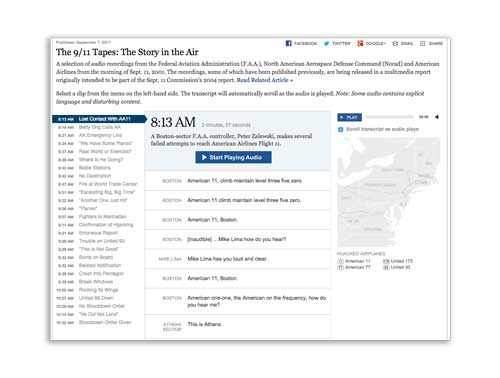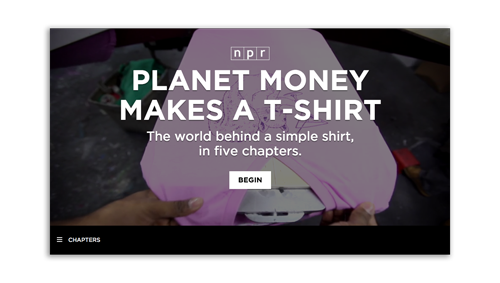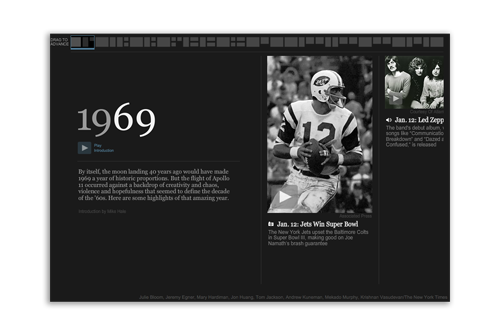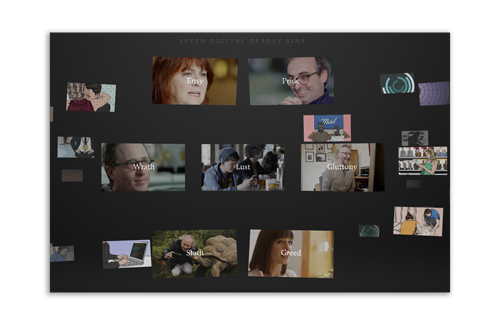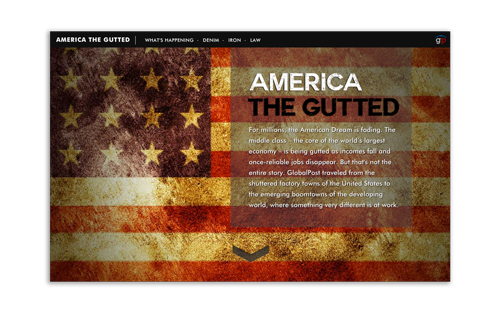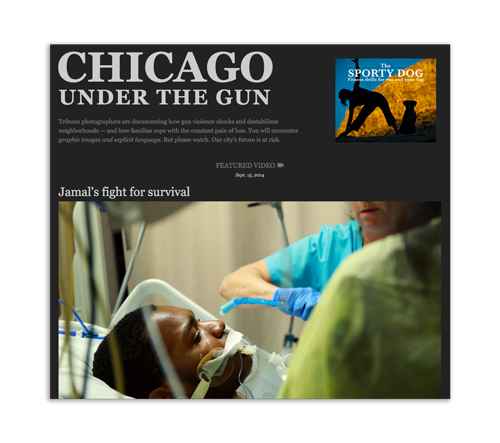Comprehensive News Stories (Case Studies)
Comprehensive News Packages
A Comprehensive package presents an in-depth environment that contains multiple discrete parts of a story under a common topic.
Instead of one linear path through the story, comprehensive packages are broken up into sections. A single story package may include multiple segments that cover different facets, such as character profiles, background information, historical information, maps or data. Some of the individual piece may be narrative in nature, but each segment is unique, and in many cases each section is told in the type of media form most appropriate for the content in that segment (i.e. video, text, graphics).
The main characteristics of these kinds of packages are the absence of a predefined path — the user gets to choose how to navigate the story by selecting the segments of most interest interest to them. This gives the consumer a high level of control over the navigation of the experience.
These packages tend to be better suited for informational than singular narrative stories. There is not just one story to tell, but a big body of information to give to the user in the most efficient method possible. This also offers the ability for users to personalize their path through story based on their own understanding of the subject matter, or their own interest in the topics presented.
- This project is more about covering a topic than a single linear story.
- This project is divided into sections or parts, intending for the user to jump around.
- This project is informational in nature.
Deconstructing / Reconstructing
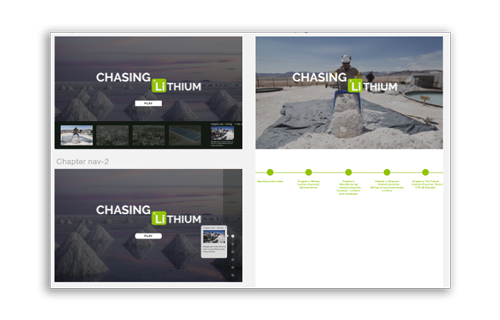
One person who thought a lot about online news presentation back in the 1990s was Leah Gentry, formerly with the Orange County Register, Chicago Tribune, and later Los Angeles Times.
In 1997, Gentry talked about the nature of Web news as a nonlinear platform and the importance of leveraging different media forms to best tell different parts of a story.
Nonlinear storytelling was a crucial part of communicating on the Web back then, partially because it mimicked our natural tendencies to want to jump around a story in a lean-forward mode, such as using a computer, versus a lean-back consumption mode, such as sitting on the couch reading a book or watching a movie.
“I used to use the analogy of talking with my mother on the phone because my mother — like everyone’s mother — starts stories in the middle, and then skips back to the front and then skips to the end and then come back to the middle. And that’s how natural conversation works. But it’s also how people’s brain works. I thought, how would it be like if we’d organize this story that way using hypertext — and so that’s how the first nonlinear storytelling project came to be and was the fertility doctor scandal at the University of California, Irvine.” - Gentry said in an interview with the authors.
The fertility fraud story won the Pulitzer that year for the Orange County Register. Designing the online component the staff decided to break the story apart into various pieces. There were multiple entry points to the fertility scandal; the clinic that deceived patients, the families who bore children that weren’t biologically theirs, and the medical research centers that unknowingly contributed to the scandal.
Form this project, Gentry espoused a process of deconstructing and then reconstructing a story to better understand its components and makeup. A single story is really multiple stories, each with a component part and told in a different medium. Separating these component parts allows for the creation of a nonlinear story where the user had complete control over how, and in which order, to consume the story.
Storyboarding
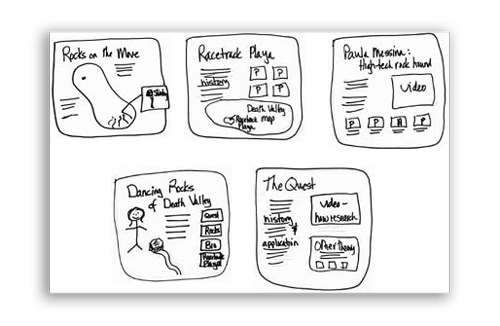
Storyboarding is a key element to many comprehensive packages. This allows you to think of the different components of your story as discrete entities. The process of storyboarding first requires a process of listing all of the different elements of a story.
Deconstruction Example
In this example, let’s take a story about the Zika virus outbreak that affected world countries in early 2016.
Step one would be to first list all of the elements of the story, then decide the media forms best suited for telling each of those parts of the story.
- Where did the virus come from? Where has it spread? Which places are most affected? (Map or other graphic.)
- What are the symptoms? How is it transmitted? What are the health effects? (Informational Graphic or text)
- What are the policy decisions being made regarding this outbreak? (Text.)
- Profiles of the people being affected by this virus. (Video or photos.)
- History of the disease. (Text.)
Next, we construct it into a cohesive story model.
Reconstruction Example
Next, we want to create a logical flow for the story. This is important because many Comprehensive story packages could end up creating clutter without a clear path through the story.
Make no mistake: While comprehensive stories are by their very nature nonlinear, it doesn’t mean you can’t create a logical path through the story that you intend for the user to follow. Nonlinear stories simply give users the freedom to jump around and consume the story out of order.
The benefit to these types of packages allows people to consume elements that are of most interest to them. It also allows the producers of these packages to pack in an immense amount of information and data that would otherwise make a Continuous story too long.
The reconstruction process is done through visual storyboarding, making drawings of how the package will be designed and flow logically. Especially important is attention to story navigation.
Case Studies
Here are some case studies featuring a few Comprehensive-style pieces.
New York Times’ 9-11 Tapes
In this piece from the New York Times about the released audio recording from 9/11, producer Matt Ericson explained that once the Times got its hands on the recordings they wanted to post as much of the recordings as possible. The Times ended up with a 33-minute long edited audio piece, consisting of audio segments from various air traffic controllers.
Since the desktop web as a medium is not very conducive to audio storytelling (without visuals), they aimed to create a project that would allow people to see through transcriptions what was being said. They also wanted to create a mechanism that would allow people to jump around if they wished, to make it more digestible in its entirety.
Ericson said he wanted to give users a sense of scope of the audio, something you don’t normally get with standard audio players on the web.
NPR Planet Money Makes a T-shirt
The Planet Money T-Shirt project began in mid-2013 as a podcast series by the Planet Money show. They decided that they would manufacture a T-shirt, and use that shirt as a narrative device for telling the story about garment manufacturing in the world economy. The project was Kickstarted and became the subject of multiple podcast episodes. Later, they brought in the web and visual teams at NPR to create a web-first news package.
(Excerpt from the Planet Money Podcast announcing the creation of the shirt.)
One of the best innovations in the project was the mixture of video, text, and graphics in a way that both presented the content and led the user through the piece. The lower navigation was key to this, showing photos of each section as the videos ended. Also an auto-scroll mechanism forced the page to scroll down once a video completed playing to reveal additional text and graphics.
In this audio clip above, producer Brian Boyer likened it to walking through a Frank Lloyd Wright house.
New York Times’ 1969 Feature
In the New York Times’ 1969 project, users are given a timeline where they can simply scroll through a project. But the nature of the project is really meant to scanned through and consumed piecemeal. Users would consume and play only the parts that interested them most.
The Guardian’s Seven Digital Sins
In partnership with NFB, The Guardian put together this package called Seven Digital Sins covering different facets of how people succumb to their vices through technology. This is a more immersive-style project, and would be considered more of an “intersection” on our taxonomy.
The choice is left to the user to go through the project at their own pace and through any entry point. While it contains an amazing visual presentation, the lack of a logical path suggests few viewers would end up seeing every part of the story. (Which arguably might have been the intention of the producers.)
Global Post’s America The Gutted
Global Post produce this piece title America The Gutted about the dwindling middle-class, outsourcing, and unemployment in many mainstay industries. These types of packages are common, which typically include a large collection of multimedia. This project is broken into sections based on various industries. The decision of how the different elements are laid out plays a major role in whether or not they will be seen by users.
Chicago Tribune’s Chicago Under The Gun
Chicago under the gun is a package on gun violence. It was produced mostly by the photographers at the paper, and contains photo slideshows and videos. The idea was to put a face to the rampant violence in the city. Many of the photo slideshow are entry points to stories written about various homicides.
